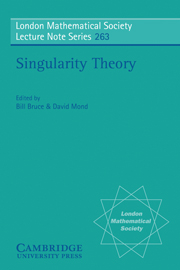 Singularity Theory
Singularity Theory Book contents
- Frontmatter
- Contents
- Preface
- Introduction
- Summaries of the Papers
- Complex Singularities
- Singularities Arising from Lattice Polytopes
- Critical Points of Affine Multiforms on the Complements of Arrangements
- Strange Duality, Mirror Symmetry, and the Leech Lattice
- Geometry of Equisingular Families of Curves
- Arrangements, KZ Systems and Lie Algebra Homology
- The Signature of f(x, y) + zN
- Spectra of K–Unimodal Isolated Singularities of Complete Intersections
- Dynkin Graphs, Gabriélov Graphs and Triangle Singularities
- Stratifications and Equisingularity Theory
- Global Singularity Theory
- Singularities of Mappings
- Applications of Singularity Theory
- References
Spectra of K–Unimodal Isolated Singularities of Complete Intersections
Published online by Cambridge University Press: 05 May 2013
- Frontmatter
- Contents
- Preface
- Introduction
- Summaries of the Papers
- Complex Singularities
- Singularities Arising from Lattice Polytopes
- Critical Points of Affine Multiforms on the Complements of Arrangements
- Strange Duality, Mirror Symmetry, and the Leech Lattice
- Geometry of Equisingular Families of Curves
- Arrangements, KZ Systems and Lie Algebra Homology
- The Signature of f(x, y) + zN
- Spectra of K–Unimodal Isolated Singularities of Complete Intersections
- Dynkin Graphs, Gabriélov Graphs and Triangle Singularities
- Stratifications and Equisingularity Theory
- Global Singularity Theory
- Singularities of Mappings
- Applications of Singularity Theory
- References
Summary
Abstract
We produce tables of spectra for all K–unimodal isolated complete intersection singularities. Their computation requires slight generalisations of the known methods for hypersurface singularities.
Introduction
The spectrum of an isolated complete intersection singularity (abbreviated: ICIS) has been denned by W. Ebeling and the author [2]. Given an ICIS (X, x), one chooses an ICIS (X′, x) with dim(X′) = dim(X) + 1 and a holomorphic function germ f : (X′, x) → (C, 0) such that X = f−1(0) and the Milnor number μ(X′, x) is as small as possible. Using the mixed Hodge structure on the vanishing cohomology of a holomorphic function f, one may define its spectrum Sp(f) = Σα∈Qnα (α) ∈ Z[Q]. If sk(X′) is the k–th Hodge number of any one-parameter smoothing of X′ and Sp(f) denotes the spectrum of f, then Sp(X, x) := Sp(f) + Σksk(X′)(k). Two properties of the spectrum have been proved in [2]: the symmetry and its semicontinuity under deformation. The spectrum is constant under deformations with both μ(X, x) and μ(X′, x) constant.
In this paper we will give the spectra for all K–unimodal isolated singularities of complete intersections; here K is the group of contact equivalences.
The K–unimodal isolated complete intersection singularities have been classified by Wall [10]. Let ℛ stand for right equivalences, i.e. diffeomorphisms of the source of a map germ.
- Type
- Chapter
- Information
- Singularity TheoryProceedings of the European Singularities Conference, August 1996, Liverpool and Dedicated to C.T.C. Wall on the Occasion of his 60th Birthday, pp. 151 - 162Publisher: Cambridge University PressPrint publication year: 1999
- 1
- Cited by
